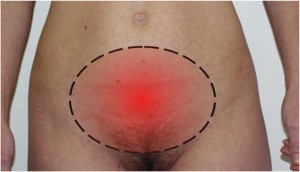Menstrual cramps (dysmenorrhea) are among the more common of menstrual cycle symptoms.
They may be mild, moderate or severe, and may not be consistent from one cycle to the next. They are usually midline and suprapubic. The cramps are waxing and waning in character but a constant dull ache is also common. The pain may radiate into the back or upper anterior thighs.

The cramps typically begin a day or two prior to the menstrual flow and are usually resolved before the menstrual flow has finished, although there is considerable person-to-person variation.
Simple cramps usually respond well to simple measures. Any of the nonsteroidal anti-inflammatory agents (Ibuprofen, naproxen, etc.) can be effective, but sufficiently high doses are most effective. A loading dose of ibuprofen, 800 mg PO can be started a day prior to the anticipated onset of cramps. This is followed by 600 mg PO every 8 hours for as long as the cramps persist. If you wait until cramps have already begun to start the NSAIDs, they will not be as effective, but may still prove useful.
Regular exercise has been demonstrated to reduce the frequency and severity of menstrual cramps, probably through the release of internal beta-endorphins.
More severe menstrual cramps usually respond very well to BCPs. Possibly through blocking of ovulation and also perhaps by the reduction in amount and duration of bleeding, BCPs are a first-line treatment for significant dysmenorrhea. Any of the low-dose, monophasic BCPs can be employed for this purpose. Significant relief should be expected after the first BCP-induced flow and additional improvement over the next 6 months may continue.
For those women with severe cramps whose symptoms are not improved with BCPs, continuous BCPs may provide the solution. In this case, the BCPs are taken without letup (continuously) and there is no menstrual flow at all. Without a menstrual flow, menstrual cramps are inhibited. For these women, gynecologic consultation while in garrison is probably wise to evaluate such patients for the possible presence of endometriosis.
